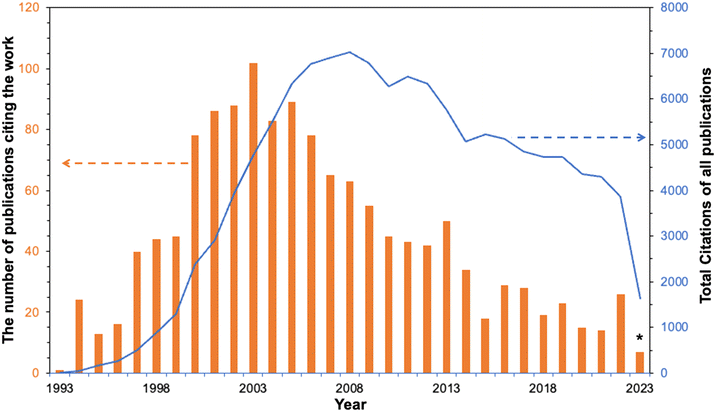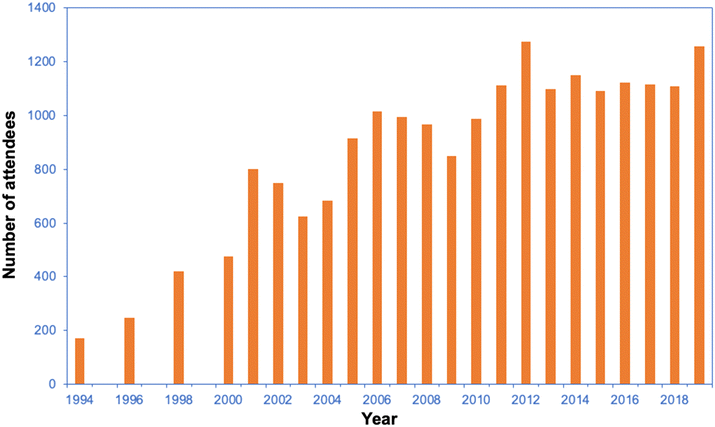Celebrating the 30th anniversary of a pioneering microfluidics paper
Z. Hugh
Fan
*abc and
D. Jed
Harrison
*d
aInterdisciplinary Microsystems Group, Department of Mechanical and Aerospace Engineering, University of Florida, P.O. Box 116250, Gainesville, FL 32611, USA. E-mail: hfan@ufl.edu
bJ. Crayton Pruitt Family Department of Biomedical Engineering, University of Florida, P.O. Box 116131, Gainesville, FL 32611, USA
cDepartment of Chemistry, University of Florida, P.O. Box 117200, Gainesville, FL 32611, USA
dDepartment of Chemistry, University of Alberta, Edmonton, Alberta T6G 2G2, Canada. E-mail: jharriso@ualberta.ca
This year we mark the 30th anniversary of the Science paper by Harrison et al.1 that is often credited for helping establish microfluidics as a research field and for popularizing the subject in academia, industry and governmental agencies. In the paper, the authors described a microfabrication method that was used to make two glass devices to carry out electroosmotic pumping and electrophoretic separation, while micromachining at that time was primarily for silicon, a traditional semiconductor substrate. While efforts to develop microsystems using microfabricated pumps and valves had been previously published, the challenge of making quality pumps using conventional mechanisms greatly limited system development. The 1993 Science paper demonstrated an alternative technology that allowed substantial integration of analytical procedures (sample injection, separation, and detection), showing the promise of the lab-on-a-chip concept, and in fact introducing the phrase, laboratory on a chip.
The impact of this pioneering paper is partially indicated by its >1500 citations according to Clarivate's Web of Science (or >2600 citations according to Google Scholar). Fig. 1 shows the number of publications citing the paper in each year from 1993 to 2023, indicating its rapidly escalating impact during the first decade of its publication and continuous influence in the second decade.
 | ||
| Fig. 1 (Columns, Y-axis on the left) The number of publications that cited the Science paper by Harrison et al.1 as a function of the year from 1993 to 2023 according to Web of Science. Note that the number for 2023 (indicated by a star at the top) is up to June of the year. (Curve, Y-axis on the right) The number of citations of all publications that cited the Science paper1 over the same period. | ||
History
While the concept of miniaturized total chemical analysis systems (μTAS) was presented in 1990 by Manz et al.,2 the Science paper in 1993 by Harrison et al.1 and other publications between those years by these two research groups3–7 demonstrated how to realize the thought-provoking idea of shrinking a laboratory onto a chip. At that time, however, the field was in its infancy and there were only a few laboratories in the world who were working on microfluidics. Nevertheless, there was significant interest from industry, as denoted in the news article published in Science in 1995.8 Several microfluidics-based companies either mentioned in the news article8 or associated with those scientists/entrepreneurs cited, including Orchid Biosciences Inc., Caliper Technologies Corp., Cepheid, and ACLARA Biosciences Inc., took advantage of the dot-com “boom” (also known as the “bubble” later on) during 1995–2000 and became public companies with a market value of more than a billion US dollars around 2000.The academic institutions and funding agencies started to catch the wave about a decade later, partially indicated by the peak of citations in 2003 in Fig. 1. The field was boosted by the inauguration of this journal, Lab on a Chip, in 2001. The curve in Fig. 1 also plots the citation number of all papers that cited the 1993 Science paper1 as a function of the year. Notably, those papers represent only a subset of microfluidics-related research during the period. The peak of this curve took place in 2008 according to Web of Science.
A similar trend can be corroborated by the attendance at the flagship conference of the field. The annual MicroTAS conference, now formally called International Conference on Miniaturized Systems for Chemistry and Life Sciences, was initially run as Workshop on Micro Total Analysis Systems9 in 1994, then as a biennial conference until 2000. Fig. 2 shows the number of attendees at every conference before the start of the pandemic of coronavirus disease 2019 (COVID-19). The attendance gradually increased from 1994 to 2006 and reached a plateau (around 1100 attendees) in 2011. It should be noted that the attendance fluctuation was partially due to locations, since the conference sites have rotated among Europe, North America, and Asia.
 | ||
| Fig. 2 The number of attendees at the annual MicroTAS conferences, which were run initially every other year until 2000. | ||
It is important to note that the field of microfluidics has grown far beyond the electrokinetic pumping and separation described in the 1993 Science paper.1 The device materials have been expanded from glass to thermoplastics, polydimethylsiloxane (PDMS), paper, and other substances. Moreover, there are many commercial successes, including the early example of the Agilent 2100 Bioanalyzer. Monetary rewards are exemplified by Danaher's acquisition of Cepheid at a value of approximately $4 billion in 2016.
Future
Microfluidics is a rapidly growing field with the potential to revolutionize many industries, including healthcare, environmental monitoring, and food safety. As the technology continues to develop, we can expect to see continuous innovation and groundbreaking applications in the next 30 years. In personalized medicine, microfluidic devices have a potential to produce drugs on demand and on the spot. They could be used to carry out genetic analysis, liquid biopsy, and tailor medical treatment to an individual patient.10 For point-of-care diagnostics, microfluidic devices could perform rapid and accurate tests in the field, doctor's offices, or hospitals. Organ-on-a-chip systems have been and will continue to be developed to mimic body parts, with a promise to replace animals for drug toxicity studies and for investigating human pathophysiology.11 Microfluidic devices could also be used to monitor environmental pollutants in real time, providing early warning of potential problems. They may be employed to detect airborne pathogens for transmission studies and for environmental surveillance of emerging viruses in a public place.12 For food/water safety, microfluidics could play a role by detecting contaminants in consumer products, food and water supplies, and recreational water environments.Microfluidics has been and continues to be expected to integrate with other technologies, including nanotechnology, 3D printing, and artificial intelligence. More powerful and versatile microfluidic devices will play a variety of roles in a wide range of applications.
Acknowledgements
We thank co-authors of the 1993 Science paper1 for their contribution to the work. We acknowledge many others for their efforts that have had significant impact to the field of microfluidics. The idea of writing this editorial was suggested by Professor Juan Santiago of Stanford University, and we appreciate the Editor-in-Chief, Professor Aaron Wheeler, for being receptive to the proposition. ZHF thanks US National Institutes of Health (R01AI155735 and R01AI158868) and Florida Department of Health (23L05) for their support to his research.References
- D. J. Harrison, K. Fluri, K. Seiler, Z. H. Fan, C. S. Effenhauser and A. Manz, Science, 1993, 261, 895–897 CrossRef CAS PubMed.
- A. Manz, N. Graber and H. M. Widmer, Sens. Actuators, B, 1990, 1, 244–248 CrossRef CAS.
- D. J. Harrison, A. Manz, Z. H. Fan, H. Ludi and H. M. Widmer, Anal. Chem., 1992, 64, 1926–1932 CrossRef CAS.
- C. S. Effenhauser, A. Manz and H. M. Widmer, Anal. Chem., 1993, 65, 2637–2642 CrossRef CAS.
- D. J. Harrison, Z. H. Fan, K. Seiler, A. Manz and H. M. Widmer, Anal. Chim. Acta, 1993, 283, 361–366 CrossRef CAS.
- K. Seiler, D. J. Harrison and A. Manz, Anal. Chem., 1993, 65, 1481–1488 CrossRef CAS.
- Z. H. Fan and D. J. Harrison, Anal. Chem., 1994, 66, 177–184 CrossRef CAS.
- R. F. Service, Science, 1995, 268, 26–27 CrossRef.
- A. van den Berg and P. Bergveld, Micro Total Analysis Systems, Springer Nature, 1994 Search PubMed.
- J. C. Contreras-Naranjo, H. J. Wu and V. M. Ugaz, Lab Chip, 2017, 17, 3558–3577 RSC.
- C. M. Leung, P. de Haan, K. Ronaldson-Bouchard, G.-A. Kim, J. Ko, H. S. Rho, Z. Chen, P. Habibovic, N. L. Jeon, S. Takayama, M. L. Shuler, G. Vunjak-Novakovic, O. Frey, E. Verpoorte and Y.-C. Toh, Nat. Rev. Methods Primers, 2022, 2, 33 CrossRef CAS.
- X. Jiang, J. C. Loeb, M. Pan, T. B. Tilly, A. Eiguren-Fernandez, J. A. Lednicky, C. Y. Wu and Z. H. Fan, Anal. Chim. Acta, 2021, 1165, 338542 CrossRef CAS PubMed.
| This journal is © The Royal Society of Chemistry 2023 |


